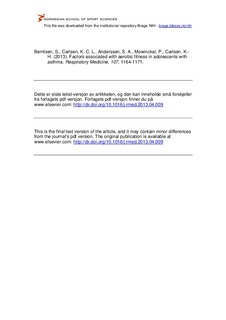| dc.contributor.author | Berntsen, Sveinung | |
| dc.contributor.author | Carlsen, Karin C. Lødrup | |
| dc.contributor.author | Anderssen, Sigmund A. | |
| dc.contributor.author | Mowinckel, Petter | |
| dc.contributor.author | Carlsen, Kai-Håkon | |
| dc.date.accessioned | 2014-01-14T12:46:57Z | |
| dc.date.available | 2014-01-14T12:46:57Z | |
| dc.date.issued | 2013 | |
| dc.identifier | Seksjon for idrettsmedisinske fag / Department of Sports Medicine | |
| dc.identifier.citation | Respiratory Medicine. 2013, 107, 1164-1171 | no_NO |
| dc.identifier.uri | http://hdl.handle.net/11250/171238 | |
| dc.description | I Brage finner du siste tekst-versjon av artikkelen, og den kan inneholde ubetydelige forskjeller fra forlagets pdf-versjon. Forlagets pdf-versjon finner du på www.elsevier.com: http://dx.doi.org/10.1016/j.rmed.2013.04.009 / In Brage you'll find the final text version of the article, and it may contain insignificant differences from the journal's pdf version. The definitive version is available at www.elsevier.com: http://dx.doi.org/10.1016/j.rmed.2013.04.009 | no_NO |
| dc.description.abstract | Background: In adolescents with asthma, information on factors associated with cardiorespiratory fitness levels is limited. The present study aimed to determine if objectively measured physical activity as well as potential relevant factors such as lung function, asthma exacerbations, use of inhaled corticosteroids or skin fold thickness are associated with direct measurements of peak oxygen uptake in adolescents with asthma.
Methods: From a nested case-control study at 13-years in the Environment and Childhood Asthma birth cohort study in Oslo, Norway, 86 13-years old adolescents with and 76 without asthma performed maximal running on a treadmill with measured. The sum of four skin fold thicknesses was recorded, followed by wearing an activity monitor for four consecutive days. Lung function was measured by maximum forced expiratory flow-volume curves and body plethysmography. Asthma exacerbations and use of medication were registered by parental structured interview. Data were analysed using multiple regression analysis.
Results: Vigorous physical activity (coefficients with 95% confidence intervals; 1.73 (0.32, 3.14)) and skin fold thickness −0.35 (−0.41, −0.28)) were significantly associated with in adolescents with asthma. Neither use of inhaled corticosteroids, lung function nor number of asthma exacerbations was associated with when taking physical activity and skin fold thickness into account. In the adolescents without asthma only skin fold thicknesses was negatively associated with −3.5 (−4.1, −2.8).
Conclusions: appears to be determined by vigorous physical activity level in Norwegian adolescents with asthma and not by asthma-related factors such as use of inhaled corticosteroids, lung function nor number of asthma exacerbations. | no_NO |
| dc.language.iso | eng | no_NO |
| dc.publisher | Elsevier | no_NO |
| dc.subject | body fat | no_NO |
| dc.subject | exacerbations | no_NO |
| dc.subject | lung function | no_NO |
| dc.subject | physical activity | no_NO |
| dc.subject | robust regression | no_NO |
| dc.title | Factors associated with aerobic fitness in adolescents with asthma | no_NO |
| dc.type | Journal article | no_NO |
| dc.type | Peer reviewed | no_NO |
| dc.subject.nsi | VDP::Medical disciplines: 700 | no_NO |
| dc.source.journal | Respiratory Medicine | no_NO |
| dc.identifier.doi | 10.1016/j.rmed.2013.04.009 | |
